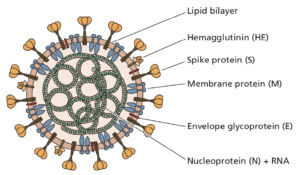

The government in Wuhan, China confirmed on 31 December that dozens of cases of pneumonia of unknown cause were being treated in that city. Pneumonia can be caused by viruses (e.g. influenza virus) and bacteria (e.g. Streptococcus pneumonia). These patients had high fever, difficulty breathing, and lesions in their lungs. No deaths have been reported. SARS and MERS coronaviruses, avian influenza viruses, and adenovirus have been ruled out as causative agents of the disease.
Many of the people who developed disease had a connection with the Huanan Seafood Market, where one can also buy poultry and wild animal meat. The connection is important because SARS coronavirus, which emerged in Southern China in 2003, was acquired from open meat markets.
A scientist leading the investigation of the new agent, Xu Jianguo, has announced that on 7 January 2020 a new coronavirus was identified. Apparently the virus was isolated from a patient and the entire genome sequence obtained. On ProMedMail he is quoted as saying €œA total of 15 positive results of the new coronavirus were detected by nucleic acid detection methods€ which I presume to be PCR. However it is not clear if this statement means that 15 patients have tested positive for this virus.
Precautions have been taken in China to limit the travel of infected individuals, for example by using thermal detectors at airports to identify people with fever. It will not be surprising if infections are detected outside of Wuhan and even in different countries, as an infected person may not have symptoms for several days.
At this point we have very little information on the virus and its transmissibility. However this situation is expected to change quickly as a diagnostic test (PCR) can now be used to track infections. Hopefully we will see the genome sequence very soon so we can determine the origin of the virus. Coronaviruses are known to circulate in bats in China and it will be essential to determine if the isolates in this new outbreak match anything that has been previously detected. I suspect not, given the assertion that the virus is a coronavirus never seen before. Nevertheless, having the genome sequence will allow us to trace its origins.
Coronaviruses have been known for many years, but until 2003 they mainly caused mild upper respiratory illness. They are enveloped viruses with a (+) strand RNA genome (pictured). In 2003 SARS coronavirus emerged as the cause of severe respiratory disease. That virus originated in cave-dwelling horseshoe bats in China, and was introduced into humans at live meat markets in Guangdong Province. MERS coronavirus emerged in the Middle East in 2012 and cases continue to be reported. It is mainly (but not always) acquired from camels, but it likely entered camels from bats some time ago. Hence coronaviruses have a proven record of causing zoonotic infections.
During the 2003 SARS outbreak, China was very slow at sharing information about the outbreak with the rest of the world. Such sharing is important because it allows other countries to detect and control the virus should it arrive. Apparently there are still issues with the current outbreak, although information is more forthcoming. For example, as reported in the NY Times, Chinese censors have blocked the hashtag #WuhanSARS on social media, and eight people are being investigated for spreading rumors online about the disease. Hopefully the sharing of information about the virus will be more open.

Comments are closed.